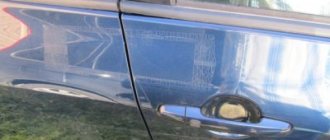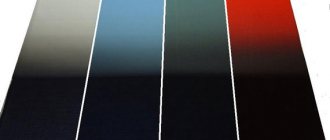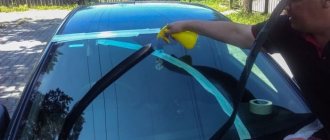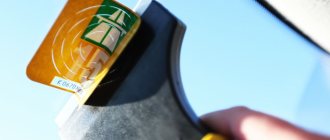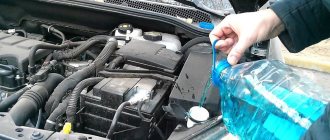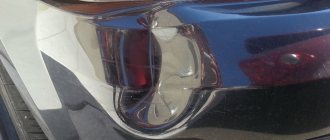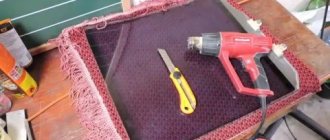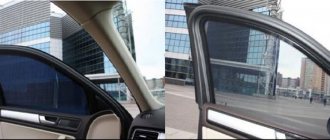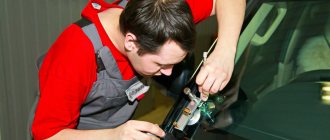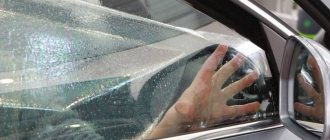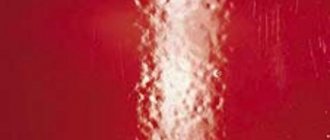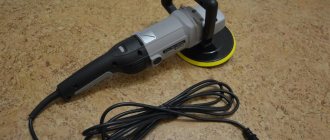The adhesive from the tint sticks firmly; removing it will require some effort.
Not all means can cope with it. It is forbidden to leave sticky marks on the glass, as they not only worsen the appearance of the car, but can also cause damage to the window regulators. Dust and small insects will settle on them.
Read the article on how to remove tinting glue from glass.
Film adhesive - what is it?
The adhesive mixture on which the tint film is placed is a high-strength adhesive agent. Due to its reliable adhesion to the surface, the tint is very difficult to tear off or cut off. Low quality film that was poorly secured is easily removed. Some Chinese-made tints peel off on their own. More expensive ones with a higher content of adhesives are difficult to remove.
The adhesion strength of the adhesive to car glass is influenced by the type of its composition.
- PS – activated under high pressure when the film is pressed hard. This is an underused option.
- DPS - activated under the influence of liquid (tinting is wetted with water before gluing).
- CD – fixed on the car glass under the influence of high temperature.
- CDF is glued with a special solution provided by the tint manufacturer.
- PS/DT – activated by a small amount of water. A spatula will help remove excess liquid.
The most difficult thing to remove is the glue from the tint, which is fixed by heating.
Recommendations
Tips for quickly and effectively removing traces of glue from tinting:
- You need to start cleaning immediately after removing the tint.
- The longer the tint was on the glass, the stronger the glue will adhere to it. For difficult cases, choose products with an aggressive composition.
- When working with any solvents, you need to take care of personal protective equipment in the form of gloves and a mask.
- After finishing cleaning, the glass must be washed and wiped dry. This will allow you to identify untreated areas and, if necessary, repeat the procedure.
When choosing a glue remover, you should always pay attention to its composition and the manufacturer’s recommendations. There are substances that cannot be used on glass surfaces.
You will find a lot of useful information about ways to remove glue from glass in this section.
Basic methods of film removal
If you have extra money, a car repair shop will help you quickly remove the tint, but you can do it yourself. There are two ways to remove tint film.
- Tear it off quickly. The tint is picked up from the edge by a sharp object, held firmly with your fingers, and pulled off sharply. This is a method of emergency removal of film from car glass, but of lower quality.
- Gradual withdrawal. The film is removed slowly, gradually heating. First, its edge is picked up with a sharp object, then a stream of hot air is supplied with a construction hairdryer. Heating should be a maximum of +60°C, only in this case the material will gently move away from the glass. During heating, the bulk of the adhesive mixture comes off along with the film.
The gradual removal method is more effective; it leaves behind a minimal amount of glue. The main difficulty is that not everyone has a hair dryer. The plastic parts of car doors are first covered with wet rags to prevent damage due to heat. If you apply air flow with a temperature above 60 °C, the glass can be damaged or deformed.
If it is impossible to heat the glass, you can remove the tint with a soap solution. The film is pryed off with a knife and slowly pulled off, pouring the solution over it. To reduce the adhesive properties of the tint, it is poured generously with liquid at the junction.
Regardless of the removal method, about 10-15% of the adhesive will still remain on the glass. It is necessary to clean it, since the side windows will no longer open normally, and dirt and insects will stick to any remaining glue.
How to remove film from glass
Tinting can be removed in one motion. Just grab its edge and pull it down sharply. But this method is not very effective. It is better to remove it gradually, slowly and carefully.
When wiping off the tint, wet it with soapy liquid, so most of the glue will go away with it.
Hot air removal
An industrial hair dryer is best suited for this method. Heat the glass with it to a temperature of 60 degrees. This way, the tint will come off along with the glue. When the tint needs to be removed from the sides, lower the window slightly. When heating, slowly pull the film down.
A hairdryer can damage the door, so be careful when using it.
Using soap solution
This method is the most popular among drivers. It is quite easy to use. It does not require much expense and does not harm the car glass.
- Use a knife to pry up the edge of the film.
- Take any soap mixture.
- Pour it over the tint and the space between it and the glass.
- Remove carefully.
How and how to remove glue after tinting glass
The easiest way to remove adhesive residues from car windows is with a hair dryer and chemical compounds. First, the window is warmed up, and then the trace of glue is removed with a napkin. Instead of a hairdryer, you can use a steam generator.
Both devices in the hands of inexperienced cleaners can harm both the car and the person. It is better for beginners not to use dangerous equipment, but to remove traces with special chemicals. means.
Soap solution
You can first soften the remaining glue with a soap solution, and then remove it with a plastic or hard rubber scraper.
- Rub the laundry soap on a grater and dilute it in warm water.
- Soak a sponge in the solution and wipe the glass. This must be done regularly so that the water does not have time to dry out.
- Treat with the solution for several minutes until the adhesive residue softens, and then remove larger pieces with a scraper.
- Small residues are removed with a napkin.
To enhance the effect of the soap solution, ammonia can be added to it.
Degreasing solution
The principle of cleaning glass will be similar to the previous one, with the difference that it needs to be moistened with a solution of car detergent. Dilute the glass cleaner with water, whip it into foam and apply it to the glass. When the solution is completely dry, clean the adhesive traces from the glass with a sponge, then wipe the surface dry with a rag.
Rust converter
The release form can be varied: sprays, suspensions. They dissolve and remove traces of rust and actively fight glue stains. Work in personal protective equipment, as this is a toxic product. It is better to wipe off the glue not in the garage, but in the fresh air and always wear gloves. The product is sprayed onto the adhesive stain, left for 10 minutes, and then simply wiped off with a rag.
A popular product is StarWax. Sold in automotive and hardware stores.
You can use WD-40 spray, which is commonly used to remove corrosion. It has a strong aroma, so they use a respirator.
Solvents
The most well-known means are acetone and white spirit. One of them needs to moisten a rag and rub the stains. If you can’t immediately remove the adhesive from the tint, you can apply the solvent again and leave it until it dries completely. After 3-4 minutes, remove the remaining softened stains with a plastic card, scraper or spatula.
Solvents are best used outdoors due to their unpleasant and toxic odor. Since they are highly flammable, smoking is prohibited while working with solvents.
Petroleum-containing substances
This group includes organic solvents such as gasoline and kerosene. The window is thoroughly wiped with a cloth soaked in them. After some time, the remaining glue softens and is removed with a plastic scraper. Due to the pungent toxic odor, you can only work in a respirator. When working with petroleum products, you must be extremely careful not to stain the seats.
Super Moment Anticley
To wash off glue from car glass, Anti-glue is applied to the dirty surface from a tube. It is gel-like and does not flow.
Anti-glue removes stains from any adhesive, even cyanoacrylate based ones.
Apply a thin layer to the window and leave for no more than an hour. The waiting time depends on the thickness of the adhesive layer. After an hour, the stain is easily washed off with soapy water.
Biosolvent Citosol
Products based on bioactive components that are not dangerous to humans and completely break down in the air in 4 days. Cytosol copes with stains on the car not only from tinting, but also from vinyl films, bitumen, and tape. Stains are removed from both glass and bodywork. The composition is applied to the window, wait 30 minutes, then the glass is washed well.
Household water repellents
After tearing off films from tinted windows, the remaining adhesive is often removed with Anti-Rain.
This is a hydrophobic preparation that disperses liquid after application to headlights, glass and streetlights. Available in the form of glue. The stains are sprayed with the solution, then you need to wait until the remaining glue softens and remove them with a plastic spatula.
Profoam 2000
The product effectively removes glue residue from tape, stickers, tint, and marker traces. Profoam 2000 tidies up not only the windows, but also the interior of the car, plastic parts, removes grease stains, traces of lubricant, and dirt in components. Available in aerosol form. It is sprayed onto the stains, left for half a minute, the stain is wiped off with a napkin, and then the glass is washed with water.
Liquid for cleaning the body from insects
Eliminates not only insect marks, but also bitumen and glue stains. Available in the form of a spray, which is sprayed onto a contaminated surface. Afterwards, just wipe with a napkin and remove any remaining dirt.
The most famous representatives:
- Hi-Gear HG 5625;
- Bag Blitz;
- Insect Remover, etc.
Glue cleaners ZM 08184 or ZM 08984
Remove remnants of tinting glue, bitumen, mastic, wax, polishing. This is a flammable material, so work with it only away from open flame sources.
A sponge is moistened with a small amount of the product, which is then used to wipe the contaminated surface. Once is enough, but sometimes repeated treatment may be necessary.
Special means
Special cleaners are available to remove glue. They have dissolving ability, are easy to apply, and do not emit a pungent odor.
List of popular glue cleaners:
- "Super Moment Anticley";
- KERRY tint remover spray;
- Koch Chemie Eulex professional cleaner;
- KUDO spray;
- glue cleaners ZM 08984, 3M 08184.
The latest products, from , have the largest number of positive reviews, smell pleasantly of citrus and quickly remove the adhesive on glass. The only negative is the high price (from 1000 rubles). Other cleaners will cost 150–500 rubles.
Safety precautions
Most chemical cleaning products are highly flammable, have a pungent odor, and emit toxic fumes that cause poisoning and damage to the central nervous system. If they get on the skin, they can cause a burn or penetrate the circulatory system.
- Do not carry out cleaning work near sources of open flame or heat. With an increased content of toxic fumes in the air, fire can also occur from very hot objects.
- All work is carried out in protective uniforms and rubber gloves to prevent contact of products with the skin.
- To prevent harmful vapors from entering the respiratory system and mucous membranes, you must work in a respirator and goggles.
Basic DIY film removal methods
You can have the tint removed by a mechanic, but there is a chance to save money by doing it yourself. Removal methods:
- Fast. You need to take the film by the edge, hook it with a sharp part, then pull it off sharply. Typically this method is used in emergency situations.
- Gradual. Tinting is removed slowly, with gradual heating. First, you need to pick up the film by the edge, then take a hair dryer and apply hot air. Heating to +40...+60 degrees is enough for the material to gently move away from the glass. Typically, most of the adhesive composition remains on the film when heated.
The second method is more effective; it allows you to remove the tint with a minimal amount of dirt remaining. Unfortunately, not everyone has a hair dryer, so the process is not always possible. Also, with strong heating, there is a risk of damage to the plastic on the doors; they will have to be covered with wet rags first. You cannot warm up the glass to more than +60 degrees, this will cause a violation of their integrity and deformation.
If it is not possible to warm up the glass, you can remove the tint from it with a soap solution. The film is lifted by the edge and slowly pulled off, pouring the solution over it. Add liquid liberally to the area where the adhesive joins the glass to reduce adhesion. Some of the glue will still remain, but no more than 10-15%. It is imperative to wipe it off: the side windows will begin to roll down poorly, and a lot of everything will stick to them.
Petroleum-containing compounds
Various mixtures of hydrocarbons are known for their solvent effect. They are used to remove traces of stickers, tape, paint and other stubborn dirt. It should be remembered that they are aggressive towards the paintwork of the car. These substances are liquids:
- petrol;
- kerosene;
- white spirit (nefras).
The algorithm for removing glue using these hydrocarbons is as follows:
- Stock up on clean rags;
- Wipe off dirt with a dampened rag;
- Wash the glass with clean water and wipe dry.
You need to work with hydrocarbon liquids with extreme care: they are toxic, volatile, flammable and can damage the paint if they come into contact with body parts.
How to remove tint correctly (for the future)
To leave a minimum of glue from the film, you need to know how to properly peel off the tint from the glass. To carry out dismantling you need to prepare:
- Construction hair dryer;
- Stationery knife.
The procedure is performed as follows:
- Using a utility knife, pry up a corner of the tint film so that you can pick it up with your fingers.
- Heat the hairdryer to 300-400°C.
- Pre-warm the work site.
- Start pulling the film with gentle force. The heated glue liquefies and lags behind the glass.
- Cut off large pieces of the removed film with a utility knife, this will simplify the process.
You can easily wipe off the glue after removing the tint film if you choose the right method. To avoid damaging the glass, you need to use only proven methods and means . You can simplify the procedure and minimize the amount of glue residue by properly dismantling the tint film.
